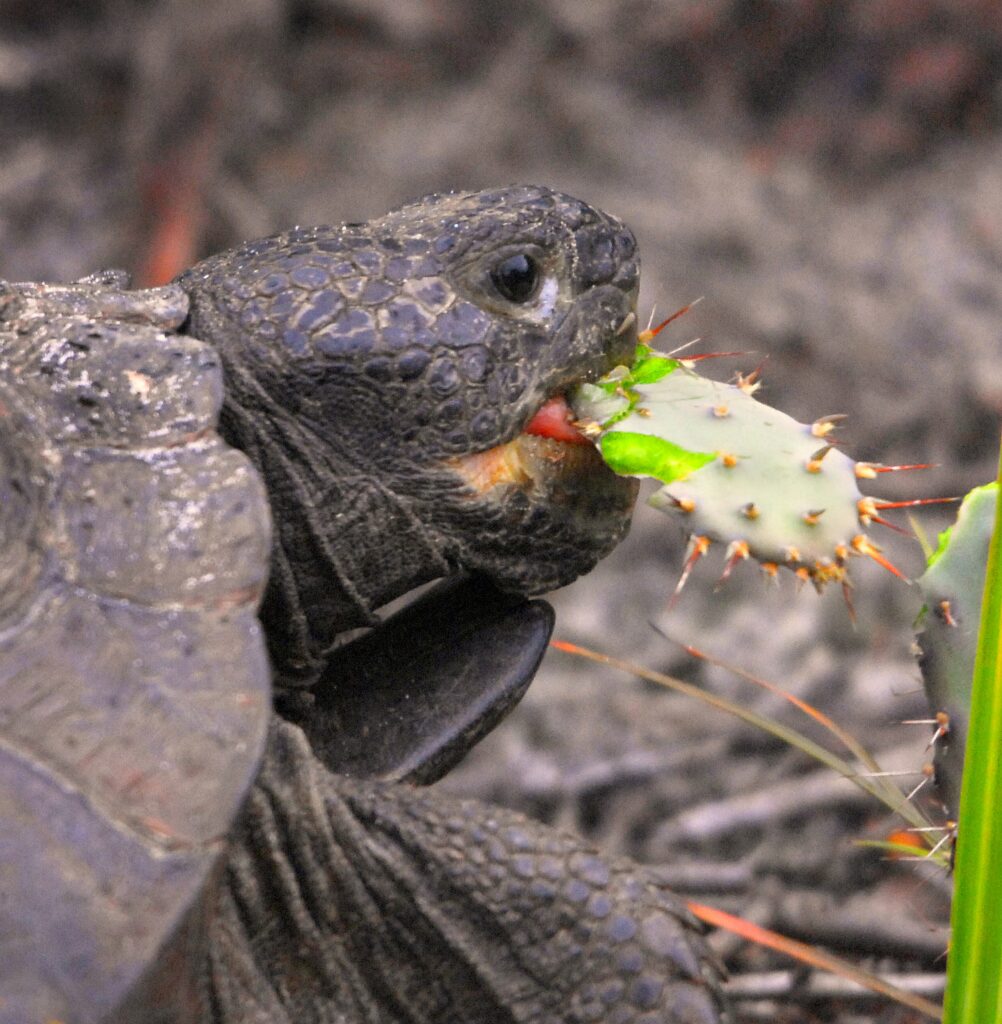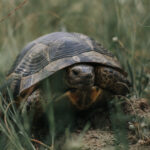
Image: Gopher Tortoise snacking on Opuntia Wikimedia Commons CC 2.0
Tortoises are amazing animals that have adapted over millions of years to their environment. One part of their diet that often interests owners and fans is the veggies they can eat. Knowing the right nutrition for tortoises is crucial for their health. Here, we’ll explore the world of tortoise-friendly veggies and provide a guide on what’s safe, beneficial, and suitable for your shelled companion.
Tortoises are herbivores, so their food mainly consists of plants. Leafy greens make up a big part of their nutrition. Kale, dandelion greens, collard greens, and turnip greens are great choices for meals. These greens are full of vitamins A and K, calcium, iron, and other nutrients that are important for a healthy diet.
Squashes like butternut squash and pumpkin are also great for tortoises. They have essential nutrients and lots of water. Carrots and sweet potatoes can also be part of their diet, but only in small amounts because of their natural sugars.
It’s important to remember that some vegetables that are safe for humans may not be good for tortoises. For example, spinach has high levels of oxalates that can stop calcium being absorbed. So, it’s important to research each veggie before adding it to your tortoise’s diet.
Also, different species of tortoises have varying food preferences based on where they come from. For instance, Mediterranean tortoises need a variety of vegetation from that area, like local weeds and wildflowers. Desert-dwelling species can survive on scarce vegetation, with adaptations that let them get water from succulent plants.
Remember: the best diet for tortoises equals a happy turtle!
Key Takeaways
- Tortoises can eat a variety of vegetables, but it is important to choose the right ones to ensure their health and well-being.
- Leafy greens like kale, collard greens, and dandelion greens are excellent choices for tortoises as they are high in nutrients and low in oxalates.
- Other suitable vegetables for tortoises include bell peppers, carrots, squash, and green beans.
- It is important to avoid feeding tortoises vegetables that are high in oxalates, such as spinach and rhubarb, as they can interfere with calcium absorption.
- Variety is key when it comes to feeding tortoises vegetables, as it helps provide a balanced diet and prevents boredom.
- It is recommended to consult with a veterinarian or reptile specialist to ensure you are providing the right vegetables and quantities for your specific tortoise species.
Importance of Proper Diet for Tortoises

The importance of the right diet for tortoises is huge. A balanced and nutritious diet is vital for their health and wellbeing. Here are four points to keep in mind:
- Variety: Tortoises need a range of different foods to have their nutritional needs met. This includes leafy greens, veg, fruit and even some flowers. Giving them a mix of these foods will ensure they get the vitamins and minerals they need.
- Calcium-Rich Foods: Calcium is key for a tortoise’s shell growth and bone development. To stop any deficiencies, offer them calcium-rich foods such as dark leafy greens, broccoli, dandelion greens and certain types of flowers.
- Limited Fatty Foods: High-fat foods like avocado should be avoided, as they may lead to obesity and other health issues. Focus on low-fat options such as cucumber, bell peppers and carrots.
- Avoid Toxic Plants: Some plants are toxic to tortoises and could cause harm if consumed. Make sure the food you provide is safe by researching it.
However, each species of tortoise may have specific dietary requirements. Talk to an expert or vet to get tailored advice for your pet.
To ensure your tortoise is happy and healthy, serve them a proper diet. This is your chance to give them the nourishment they need – your tortoise will thank you!
General Guidelines for Feeding Tortoises
Feeding tortoises is a must for their health and well-being. Here’s a 3-step guide to general guidelines for feeding these reptiles.
- Variety:
- Give a variety of veggies to your tortoise.
- Choose dark leafy greens like kale, collard greens, and dandelion greens.
- Supplement with carrots, bell peppers, and squash.
- Aim for a colourful platter.
- Go Organic:
- Opt for organic veggies whenever possible.
- Avoid those treated with pesticides or herbicides.
- Moderation:
- Offer an array of veggies but in moderation.
- Overfeeding can lead to health issues.
- Monitor portion sizes according to size and age.
Remember, some tortoises may have special dietary needs – consult a reptile vet or do research for insight. Provide fresh water too – hydration is key. Serve safe veggies for a true herbivore connoisseur!
Specific Vegetables Safe for Tortoises
No doubt, tortoises have special diets. So, it’s important to make sure to include a variety of healthy veggies! Here’s a list of safe veggies that will make them thrive:
| Veggie | Nutrients | Benefits |
|---|---|---|
| Leafy Greens | Fiber, Vitamin A | Digestion & Eye Dev. |
| Bell Peppers | Vitamin C, Antioxidants | Immunity & Essential Nutrients |
| Squash | Vitamin E, Calcium | Bones & Tissue Repair |
| Carrots | Beta-carotene, Fiber | Immune Function & Optimal Gut Health |
Dark leafy greens, like kale and dandelion greens, are particularly important for tortoises. They’ve got high calcium content. Plus, mustard greens and turnip greens offer lots of good nutrients and tasty variety.
Did you know that the ancient Egyptians believed that pet turtles had special power? They even fed them leafy greens to give them strength and long life. Now we know how important these veggies are for our shelled friends, too!
Cooking for tortoises may be tricky. But at least they won’t complain about your cooking skills!
How to Prepare Vegetables for Tortoises
Preparing veggies for tortoises must be done with care. Here’s a guide on how to do it:
- Pick fresh, safe veggies like kale, spinach, dandelion greens, and non-spicy peppers & carrots.
- Scrub them to remove dirt & pesticides.
- Chop them into small pieces.
- Steam or boil the tougher veggies.
- Put them in a shallow dish inside the enclosure. Remove leftovers after a few hours.
Remember, some veggies are not safe for tortoises. Avoid onions, garlic, & mushrooms. Research your pet’s species & age to provide a balanced diet.
Did you know? In ancient Egypt, tortoises were sacred animals. They were connected with gods & used in religious rituals. That shows their long-standing presence across cultures.
Feeding Techniques for Tortoises: Outsmart the tortoise & make it think it’s winning the food race!
Feeding Techniques for Tortoises
Feeding Tortoises requires particular techniques to guarantee their health and joy. Here are a few focuses to remember:
- Fabricate a balanced diet: Give a range of veggies, fruits, and greens to guarantee your tortoise gets all the fundamental supplements.
- Offer calcium-rich nourishments: Tortoises need calcium for solid shell development, so incorporate calcium-rich nourishments like kale, broccoli, and dandelion greens in their diet.
- Stay away from toxic plants: Be cautious about the plants you present into your tortoise’s pen as numerous basic family unit plants can be poisonous to them. Do broad exploration before adding any new greenery.
- Offer food in fitting sizes: Cut vegetables and fruits into small pieces that are simple for the tortoise to eat. This will forestall choking or blockages in their digestive system.
- Screen nourishing propensities: Observe your tortoise during feast times to guarantee they are eating appropriately. In the event that you notice any changes in hunger or conduct, counsel a veterinarian for direction.
Moreover, consider the dampness levels in their enclosure. Excessive humidity can lead to respiratory issues.
Furthermore, in Ancient Greek mythology, it was accepted that giving wine-soaked lettuce leaves to newborn infant tortoises would make them develop quicker. This practice has no scientific basis and is not suggested today. Yet, it demonstrates the long-standing fascination with tortoises throughout history.
By following these correct encouraging systems and understanding the unique needs of your tortoise, you can guarantee a sound and cheerful life for these remarkable creatures. To finish, it’s obvious that even tortoises favor their veggies over moderate paced reality shows – sorry, Kardashians!
Frequently Asked Questions
Q: Can tortoises eat lettuce?
A: Yes, tortoises can eat certain types of lettuce, such as romaine lettuce, but it should only be given in moderation as it has low nutritional value.
Q: What vegetables should I avoid feeding my tortoise?
A: Avoid feeding your tortoise vegetables that are high in oxalates, such as spinach and rhubarb. These can interfere with calcium absorption and lead to health issues.
Q: Can tortoises eat carrots?
A: Yes, carrots are safe for tortoises to eat, but they should be given in small amounts due to their high sugar content. Too many carrots can cause digestive problems.
Q: Are tomatoes suitable for tortoises?
A: While tomatoes are not toxic to tortoises, they contain high levels of acidity and should be offered sparingly. Overconsumption may cause gastrointestinal upset.
Q: Can tortoises eat cucumbers?
A: Yes, cucumbers can be included in a tortoise’s diet. They provide hydration but should be given in moderation as the peel may be challenging to digest.
Q: Is it safe for tortoises to eat bell peppers?
A: Yes, bell peppers (green, red, or yellow) are safe for tortoises. They offer essential vitamins and can be fed in small amounts as part of a balanced diet.
Conclusion
Tortoises have a diverse diet, but it’s important to know which veggies they can eat. To provide them essential nutrients, offer them a variety of veggies. Not all of them are suitable, though. Let’s explore!
Leafy greens should be a major part of their diet. Dandelion greens, kale, and collard greens are excellent choices. They help keep the shell healthy and support overall health.
Bell peppers are also an option, but feed in moderation due to high Vitamin C levels. Squash, zucchini, and cucumbers are hydrating, and cucumbers should have the seeds removed first. Tomatoes can also be given occasionally, even if they’re not nutrient-dense.
Species may have different dietary needs so talk to a vet or herpetology specialist for personalized advice.
The Tortoise Trust website advises against spinach or lettuce due to oxalic acid interfering with calcium absorption – vital for shell growth.
Tortoises will thrive when given a balanced diet of appropriate leafy greens and some veggies. Make sure to offer suitable options for their well-being and happiness.
References




